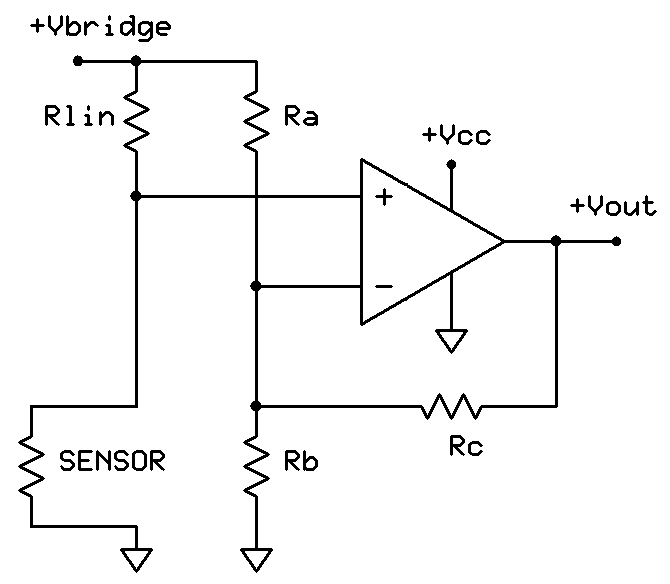Signal conditioning hardware
Hmm, there seems not to be that much in it. This is a typical measurement bridge with the addition of DC voltage amplifier. But the simplicity is deceptive - this circuit achieves excellence not through complexity but through carefull adjusting of resistor and voltage values it uses. Let's analyse it.

Left branch of the measurement bridge is formed by the linearising resistance Rlin connected in series to the sensing element. Physical property that carries temperature data is DC voltage at the midpoint, picked by the noninverting input of the operational amplifier. As has been mentioned, this is actually all we need to make "temperature-to-voltage" transfer characteristics of KTY type sensors linear. But obviously, not just any resistor will act fine as Rlin. For each given temperature range, there is an exact Rlin resistance that makes output voltage change exceptionally linear. As this value is not easy to find out numarically, we have developed a PC application that enables its accurate estimation. Application functions are explained thoroughly on the next page.
Right branch of the bridge is formed by resistors Ra and Rb, while Rc sets operational amplifier gain. Ra and Rb set a fixed reference DC voltage to which the amplifier continually compares sensor voltage; it then amplifies the difference by (1 + Rc/(Ra||Rb)) factor ratio and provides the result on its output. By carefull setting of Ra, Rb and Rc values, it is possible to fulfill these two conditions: Vout = 0V at T = Tmin and Vout = Vout_max at T = Tmax. Output voltage Vout(T) then rises linearly from 0V to Vout_max between Tmin and Tmax. As input and output voltages are referenced to ground, operational amplifier needs only a single side (positive) power supply. It should be able to provide 0V on its output i.e. should have "negative rail" output capability; fortunately, ubiquitous and cheap LM358 and LM324 series integrated circuits are up to the task.
A circuit designer can choose Rb value at will. It is a good practice to make the equivalent galvanic resistances connected to inverting and noninverting inputs of an operational amplifier equal - this way, the instability of its DC output voltage due to input current temperature drift will be minimised. In this circuit, picking Rb value being approximately equal to KTY sensor resistance at an approximate middle of the temperature range in interest is recommended. For example, Rb = 2,2 kΩ is a good choice for a circuit optimising KTY81-210 performance between -10'C and +50'C.
At this point, it is not yet clear what the value of Vbridge should be - operational amplifier surrounding components can be optimised to put Vout into the desired voltage span for a broad range of Vbridge values. As will be explained on the next page, this degree of freedom can be exploited in an unusual but rather convenient way.
As for picking Vout_max value, if an A/D converter is to be used, it is desirable to choose Vout_max to be equal to Vacd_max i.e. maximum output voltage of the operational amplifier should be equal to maximum input voltage of the A/D converter. This way, the largest possible signal-to-noise ratio in the digital part of the measurement system will be achieved. Maximum input voltage is a standard parameter given in any A/D converter or microcontroller datasheet. If an analog galvanometer is to be connected to the amplifier output pin, then Vout_max choice is less critical as it is easy to set the galvanometer current to reach its maximum value Imax at any particular Vout_max via an additional resistor connected in series with it. Note, however, that Vout_max cannot be set higher than the maximum output voltage the operational amplifier is able to produce at a given Vcc. For example, LM358/324 ICs cannot produce more than Vout = Vcc - 1,2V at their outputs for any given Vcc. Some newer operational amplifiers referred to as having "positive rail" outputs can produce Vout as high as Vcc, but that is not necessary in this application.

 Left branch of the measurement bridge is formed by the linearising resistance Rlin connected in series to the sensing element. Physical property that carries temperature data is DC voltage at the midpoint, picked by the noninverting input of the operational amplifier. As has been mentioned, this is actually all we need to make "temperature-to-voltage" transfer characteristics of KTY type sensors linear. But obviously, not just any resistor will act fine as Rlin. For each given temperature range, there is an exact Rlin resistance that makes output voltage change exceptionally linear. As this value is not easy to find out numarically, we have developed a PC application that enables its accurate estimation. Application functions are explained thoroughly on the next page.
Left branch of the measurement bridge is formed by the linearising resistance Rlin connected in series to the sensing element. Physical property that carries temperature data is DC voltage at the midpoint, picked by the noninverting input of the operational amplifier. As has been mentioned, this is actually all we need to make "temperature-to-voltage" transfer characteristics of KTY type sensors linear. But obviously, not just any resistor will act fine as Rlin. For each given temperature range, there is an exact Rlin resistance that makes output voltage change exceptionally linear. As this value is not easy to find out numarically, we have developed a PC application that enables its accurate estimation. Application functions are explained thoroughly on the next page.